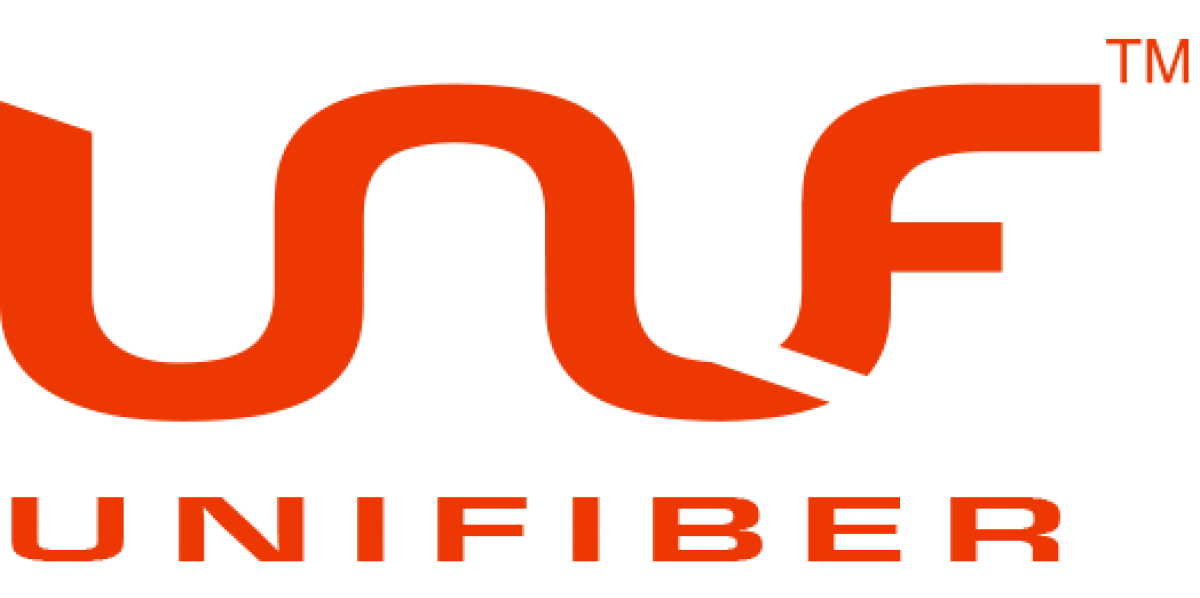
Delivering broadcast TV over fiber networks
With spiraling pace of fiber deployments around the world replacing coax nearly in all new builds, the demand for a reliable cost-effective solution for distributing satellite and terrestrial TV over fiber networks is on the rise.
Their low-loss and high throughput capacity makes fiber networks ideal for delivering TV services and possibly with combined broadband data to high-rise buildings, apartment blocks, hotels, campuses, residential communities as well as any other FTTx deployments.
Inverto’s Unifiber™ product line enables an integrated TV installation delivering all satellite and DTT services over a single optical fiber, reducing the number of antennas and devices in the installation without compromising the quality of the terrestrial and satellite TV signals. A wide range of Unifiber™ optical receivers is available to support any type of in-building and/or in-home distribution. A range of professional Unifiber™ EDFAs (optical amplifiers) can be added to easily extend the optical signal distribution to thousands of homes.
The Unifiber™ benefits
- A complete product range enabling end-to-end TV distribution MDU/IRS installations reaching up to thousands of homes.
- High performance single wavelength transmitting headend (1310 nm or 1550 nm) with built-in AGC delivering a balanced end-to-end TV signal for all DTT and satellite services for the best viewing experience.
- Noise-free Installations without interference’s to the TV transmission benefiting installers with considerable savings in installation times.
- Supporting both hybrid and overlay installations - compatible with GPON deployments, share the same fiber used for broadband data services to incorporate TV services.
- Wide range of optical receivers with superb sensitivity accommodating any type of in- building / in-home distribution
- Cost effective equipment, low power consumption and small footprint
- Future proof technology
The Unifiber™ transmitting headend consist of a wideband LNB and an optical transmitter. An optional DTT processing unit is available in case distribution of UHF DTT is required. The wideband LNB and the DTT processing unit are connected to and powered by the optical transmitter. The optical transmitter applies smart AGC to balance the satellite and the DTT signals for optimal distribution across the fiber network using a 1310nm or 1550nm wavelength optical signal. Adding a Unifiber EDFA to the output of a 1550nm transmitter will amplify the optical signal and allow extend the signal distribution to thousands of homes.

Receiving
The Unifiber™ solution offers a wide range of optical receivers with different sort of output ports to accommodate any type of in-building or in-home distribution over coax cables. The range includes receivers with Quattro, Wideband, Quad and dCSS/dSCR output ports with combined DTT signal as well as separate DTT-only output ports. A built-in AGC combined with a highly sensitivity front-end circuitry deliver robust reception capabilities making them ideal for MDU/IRS installations where optical signal levels may become edgy as a result of the numerous cable splices.

EDFA’s
Inverto’s Unifiber™ EDFA product range of optical amplifiers is based on state-of-the-art laser pumps and world-class 1550nm Erbium-Doped Fiber, suiting a variety of video distribution applications and including models with integrated wave length multiplexer (WDM) that can overlay 1310nm/1490nm data signals from a GPON/EPON OLT device over a single fiber port. Engineered to last, the Unifiber™ EDFA’s smart power management and thermal design ensures long lifetime, high reliability and stable performance of the laser pump. The front panel’s large LCD display provides easy to use configuration and setup menu and serves the user with operation status information and/or warning alerts whenever needed. Delivered in a 19” 1RU rack mount housing with two hot-swappable power supply units, the Unifiber™ EDFA products are easy to integrate and guarantee that your signal distribution is always on.

Receiving
The Unifiber™ solution offers a wide range of optical receivers with different sort of output ports to accommodate any type of in-building or in-home distribution over coax cables. The range includes receivers with Quattro, Wideband, Quad and dCSS/dSCR output ports with combined DTT signal as well as separate DTT-only output ports. A built-in AGC combined with a highly sensitivity front-end circuitry deliver robust reception capabilities making them ideal for MDU/IRS installations where optical signal levels may become edgy as a result of the numerous cable splices.

EDFA’s
Inverto’s Unifiber™ EDFA product range of optical amplifiers is based on state-of-the-art laser pumps and world-class 1550nm Erbium-Doped Fiber, suiting a variety of video distribution applications and including models with integrated wave length multiplexer (WDM) that can overlay 1310nm/1490nm data signals from a GPON/EPON OLT device over a single fiber port. Engineered to last, the Unifiber™ EDFA’s smart power management and thermal design ensures long lifetime, high reliability and stable performance of the laser pump. The front panel’s large LCD display provides easy to use configuration and setup menu and serves the user with operation status information and/or warning alerts whenever needed. Delivered in a 19” 1RU rack mount housing with two hot-swappable power supply units, the Unifiber™ EDFA products are easy to integrate and guarantee that your signal distribution is always on.
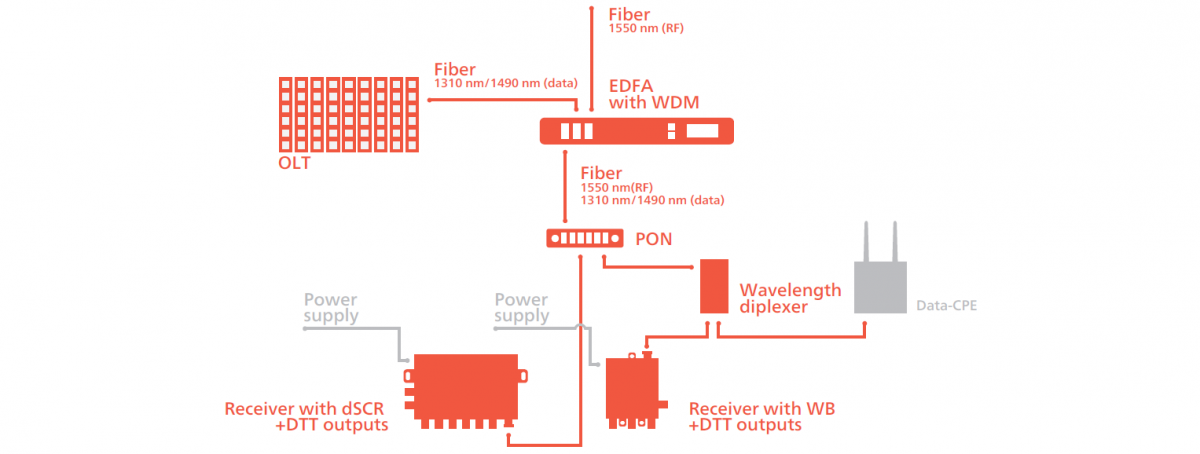
RF-over-Fiber Satellite and Terrestrial TV distribution applications
Single-cable Sat TV distribution using static dCSS/Unicable LNB
RF overlay for Fiber-To-The-Riser deployments:
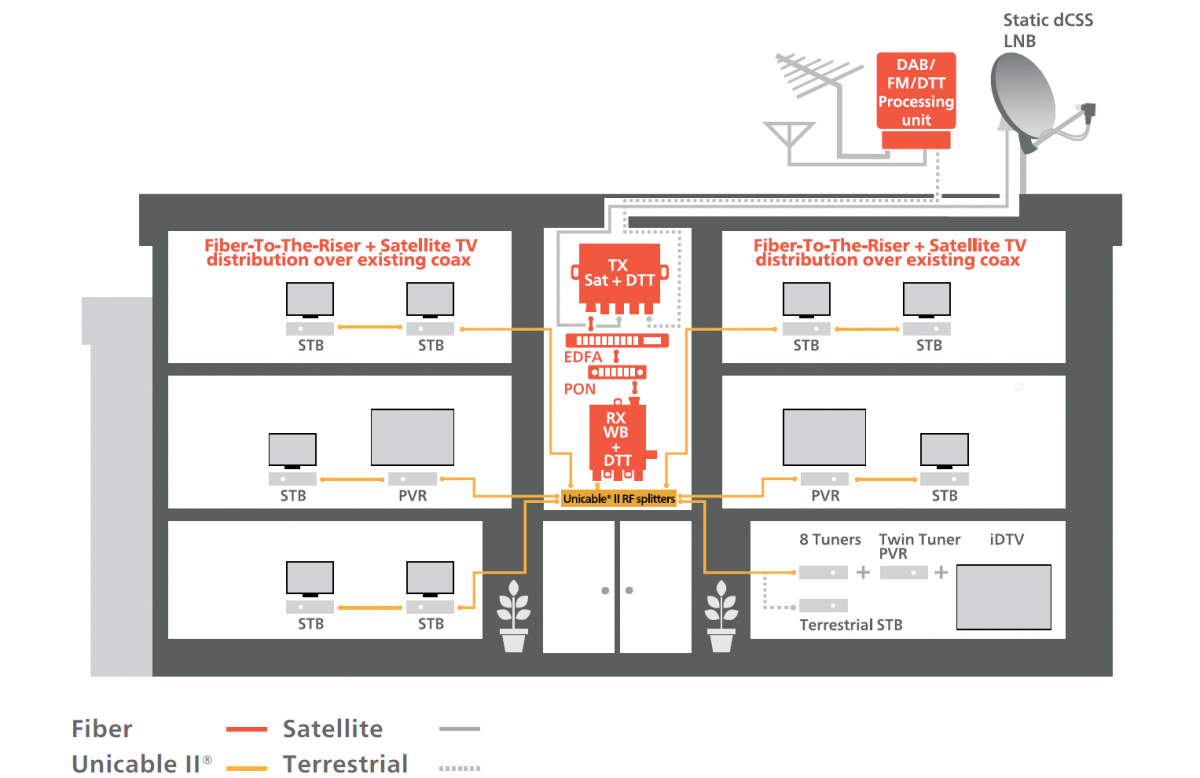
Many DTH services are delivered to subscribers homes over a single-cable installs using, for example, a dCSS/Unicable II LNB operating in Static mode. The LNB output RF signal is then distributed over a coax cable to the riser, through the building and inside the homes using simple RF splitters and coaxial cables. Large installations with lots of coax splits, noisy, long or poor quality cables and connectors will require numerous line amplifiers, filters and power inserters to be installed with a high toll on installer time spend at site in order to deliver sufficient signal quality. Upgrading the installation with a fiber-to-the-riser and using a Unifiber transmitting headend will deliver a higher quality signal, save the installer significant time simplify the installation substantially. In this case, the LNB RF signal is connect a 1310nm Unifiber transmitter (DTT signal can be connected and distributed over the same fiber too) and the optical output signal can be distributed over a simple PON to a Unifiber wideband receiver to convert the optical signal back to RF. The RF signal can then be distributed to the homes over the existing coax cables. Optionally, a 1550nm transmitter connected to a Unifiber EDFA can be used to boost the optical signal to reach thousands of homes.
Fiber-To-The-Home deployment including data services via EDFA’s WDM input:
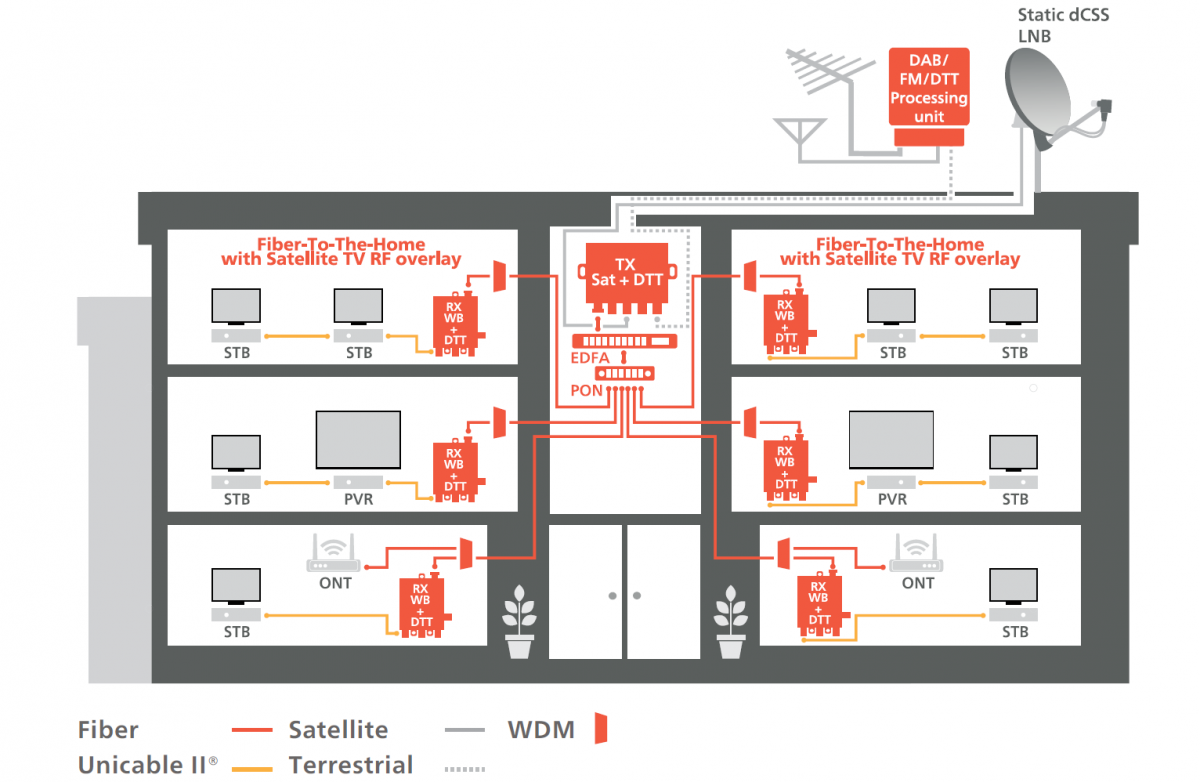
As the penetration of fiber networks increases, and specifically in new builds, more and more homes are being connected with a fiber cable for the delivery of broadband data and TV services. The Unifiber solution allows installers to utilize the same fiber core that carries the broadband data service to overlay the RF output signal of the LNB and deliver the satellite TV (and DTT) services to subscribers’ homes directly. The output RF signal of the LNB is connected to a 1550nm Unifiber transmitter (DTT signal can be connected and distributed over the same fiber too) whose output is then connected to a Unifiber EDFA device with built-in WDM inputs. The EDFA’s WDM inputs are connected to the equipment of the data service provide in the building and the output ports of the EDFA will then carry both data and TV services over the same fiber core. A common WDM (Wavelength De-Multiplexer) device installed in the subscriber home then separates the data service (usually delivered over 1310nm + 1490nm wavelengths) and the TV services over two independent optical output ports. The data port will be connected to a data optical network termination device (usually a Wi-Fi router provided by the data service provider) while the TV output port will be connected to a Unifiber wideband receiver to convert the optical signal back to RF and distribute it to STBs and TVs around the home over coax cables. In some cases, for redundancy and resiliency purposes, the data service and the TV services will not share the same fiber core but different cores over the same fiber cable. In these cases, a lower-cost 1310nm Unifiber transmitter can be used instead of the 1550nm model, the WDM inputs of the EDFA can be skipped and there will be no need to install a WDM device in the subscriber home.
Sat TV distribution using Wideband LNB
Residential Fiber-to-the-Home/Floor/Building:
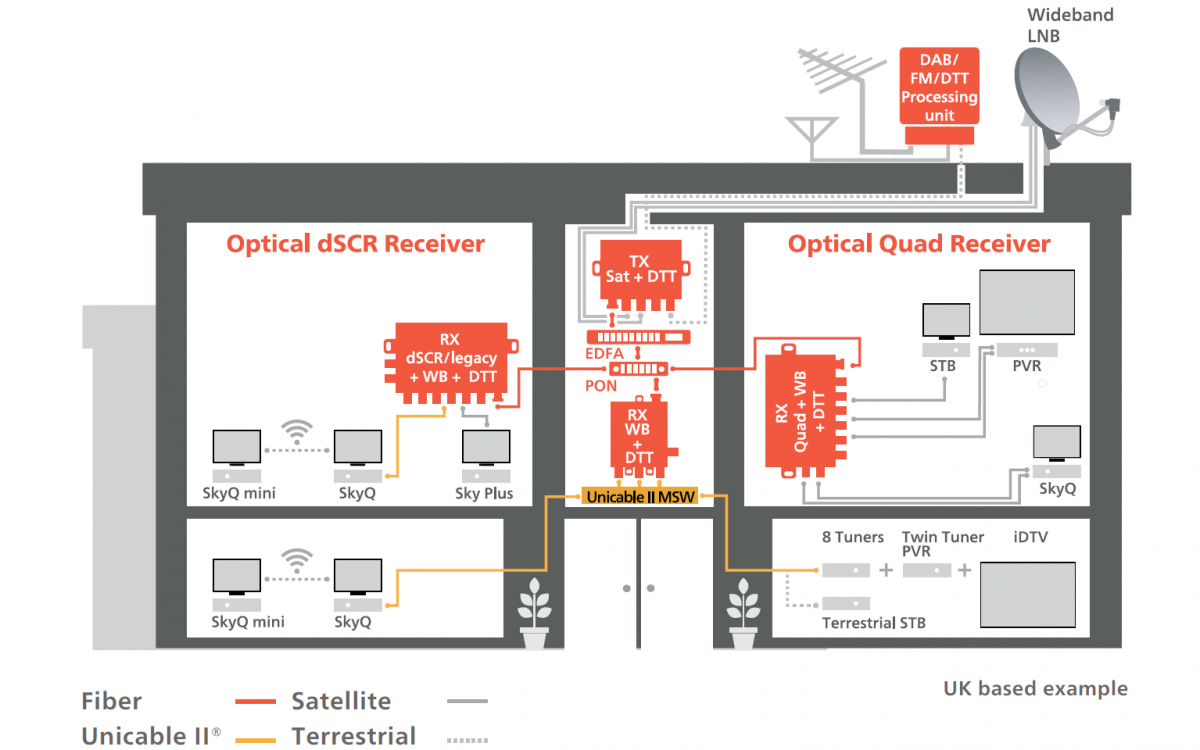
The Unifiber™ transmitter distributes satellite and terrestrial signals over a single fiber cable. Satellite reception is fed in via a wideband LNB and DTT signals (FM/DAB/DTT) via a Unifiber™ DTT processing unit. A built-in RF-AGC for the satellite inputs together with the UHF-AGC at the DTT Processing unit make sure the transmitter output signal remains optimal for high quality TV signal distribution.
The optical signal can be distributed over a Passive Optical Network (PON) and can be amplified through a Unifiber™ EDFA optical amplifier to support large scale deployments. dCSS and Quad optical receivers can be used for FTTH (Fiber To The Home) installations while Quattro and Wideband receivers can be used for FTTB (Fiber To The Block) or FTTF (Fiber To The Floor) installations.
Commercial MDU/IRS Fiber-To-The-Home/Floor/Building:
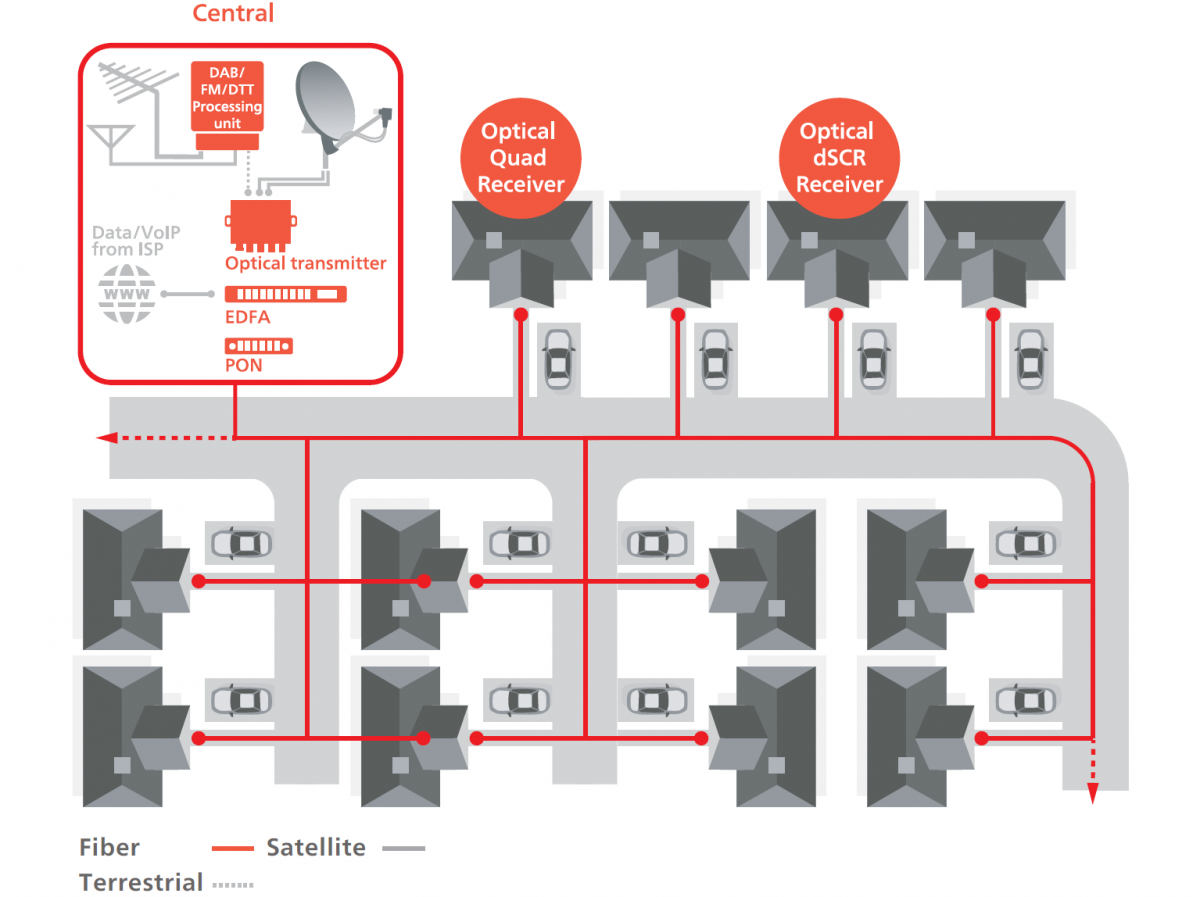
Scaling Fiber-to-the-Home TV distribution in large residential areas has never been simpler - The optical signal of the transmitter’s output is amplified through a Unifiber™ EDFA optical amplifier and then distributed to individual homes over PON. A dSCR or Quad optical receivers are installed at the homes and distribute the TV signal to STBs and TVs over coax cables. A range of EDFAs with an integrated WDM can interconnect with the telco’s GPON OLT equipment and combine the broadband data (IP @1310 nm +1490 nm) and the TV (RF @1550 nm) services over a single fiber cable.
Fiber-To-The-Home deployment including data services via EDFA’s WDM input:

As the penetration of fiber networks increases, and specifically in new builds, more and more homes are being connected with a fiber cable for the delivery of broadband data and TV services. The Unifiber solution allows installers to utilize the same fiber core that carries the broadband data service to overlay the RF output signal of the LNB and deliver the satellite TV (and DTT) services to subscribers’ homes directly. The output RF signal of the LNB is connected to a 1550nm Unifiber transmitter (DTT signal can be connected and distributed over the same fiber too) whose output is then connected to a Unifiber EDFA device with built-in WDM inputs. The EDFA’s WDM inputs are connected to the equipment of the data service provide in the building and the output ports of the EDFA will then carry both data and TV services over the same fiber core. A common WDM (Wavelength De-Multiplexer) device installed in the subscriber home then separates the data service (usually delivered over 1310nm + 1490nm wavelengths) and the TV services over two independent optical output ports. The data port will be connected to a data optical network termination device (usually a Wi-Fi router provided by the data service provider) while the TV output port will be connected to a Unifiber wideband receiver to convert the optical signal back to RF and distribute it to STBs and TVs around the home over coax cables. In some cases, for redundancy and resiliency purposes, the data service and the TV services will not share the same fiber core but different cores over the same fiber cable. In these cases, a lower-cost 1310nm Unifiber transmitter can be used instead of the 1550nm model, the WDM inputs of the EDFA can be skipped and there will be no need to install a WDM device in the subscriber home.
Sat TV distribution using Wideband LNB
Residential Fiber-to-the-Home/Floor/Building:

The Unifiber™ transmitter distributes satellite and terrestrial signals over a single fiber cable. Satellite reception is fed in via a wideband LNB and DTT signals (FM/DAB/DTT) via a Unifiber™ DTT processing unit. A built-in RF-AGC for the satellite inputs together with the UHF-AGC at the DTT Processing unit make sure the transmitter output signal remains optimal for high quality TV signal distribution.
The optical signal can be distributed over a Passive Optical Network (PON) and can be amplified through a Unifiber™ EDFA optical amplifier to support large scale deployments. dCSS and Quad optical receivers can be used for FTTH (Fiber To The Home) installations while Quattro and Wideband receivers can be used for FTTB (Fiber To The Block) or FTTF (Fiber To The Floor) installations.
Commercial MDU/IRS Fiber-To-The-Home/Floor/Building:

Scaling Fiber-to-the-Home TV distribution in large residential areas has never been simpler - The optical signal of the transmitter’s output is amplified through a Unifiber™ EDFA optical amplifier and then distributed to individual homes over PON. A dSCR or Quad optical receivers are installed at the homes and distribute the TV signal to STBs and TVs over coax cables. A range of EDFAs with an integrated WDM can interconnect with the telco’s GPON OLT equipment and combine the broadband data (IP @1310 nm +1490 nm) and the TV (RF @1550 nm) services over a single fiber cable.